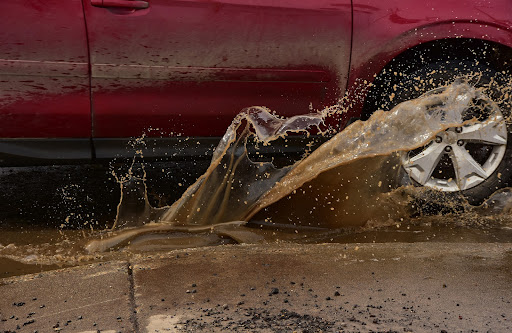
Potholes are not only an eyesore but can also do serious damage. But what exactly are the causes of potholes in the first place? And is there a way to prevent them?
Potholes offer no substance or benefit to drivers or property owners. They can cause many problems, including trip-and-fall injuries and costly vehicle damage. They are also very unattractive, thereby bringing down curb appeal and, in turn, property values. Beyond anything else, they can invite potential liability.
But what causes potholes on gravel roads anyway? And what can you do to prevent or remedy them? Find out below.
Even the most durable of roads can suffer from potholes over time. Time brings aging, and aging brings wear and tear. Roads don’t stay smooth and strong forever, especially when exposed to the elements.
Roads and pavements become less flexible as time passes, making them more vulnerable to water. When left to stand, water can cause erosion and create cracks on the surface. The layers below get washed away in the process. Add heavy traffic and freezing temperatures, and you have a formula for potholes.
Proper maintenance is the best way to prolong the life of roads and pavements. Of course, remember that even with the strictest maintenance routines, potholes can still form given the right conditions and enough time.
Rainy days and cold temperatures can make for a cozy night in. But they can also contribute to the formation of potholes. So what type of weathering causes potholes?
Freezing temperatures, in particular, are a common culprit. Asphalt and concrete can absorb water. And when water seeps into the subbase, freezing temperatures can turn the water into ice. When that ice melts away as the temperature comes back up, it creates a void in the subbase. Cracks will then soon form above.
Heavy loads and constant traffic will compromise the surface when there are cracks and voids in the pavement. As a result, potholes will form. When left alone, potholes can expand and even multiply.
While there is nothing you can do about the weather, some things are within your control. For instance, it is a good idea not to leave standing water on roads and pavements. Due to the freeze/thaw cycle, you might notice that potholes happen more often in the colder months.
What type of erosion causes potholes? Erosion is a huge contributor to pothole formation. And water is a key component of erosion, particularly standing water.
When water does not drain properly, it can permeate the ground. Again, this is where cold temperatures come in. If the temperature drops low enough, the water can freeze over and force the surrounding area to expand, thus creating a gap in the subbase. The surface above will then start to form cracks.
It might seem like an obvious solution, but you’d be surprised how many property owners don’t account for proper water drainage. If you want to avoid standing water, hire a professional to inspect your roads and pavements to ensure water can drain correctly.
Heavy traffic is another one of the causes of potholes in road pavement. If you regularly drive through a major road or main intersection, you will notice that potholes occur there more often than in other places. This is because of high traffic and heavy loads, especially when large trucks pass through.
Roads and pavements that experience more traffic are more likely to get potholes. It’s not rocket science – the heavier the surface’s weight, the higher the chance of compromise. They eventually lose their flexibility and start to form cracks. Voids will soon form underneath the surface, and potholes are not too far behind.
Maintenance is necessary if you have a surface that experiences a lot of traffic. Hire a professional to conduct frequent inspections and do all necessary maintenance work.
One of the causes of potholes in asphalt is the poor durability of the material itself. Asphalt is a popular choice of material for roads and pavements. This is due to the easy application of the material and its porous nature.
Porous materials allow for better noise absorption but are also weaker than other materials. Water more easily seeps into the subbase; by now, you know that water is a major cause of potholes.
What makes potholes? Poor patching is one. The surface is already compromised when contractors don’t apply asphalt or concrete properly right from the start. This will more easily let water inside and cause erosion.
Contractors should practice care when installing asphalt or concrete for the first time. Moreover, roads and pavements should have proper maintenance, ideally daily. But, even during the maintenance cycle, contractors can make mistakes, resulting in poor patching. This will then expose the surface to the risks associated with pothole formation.
Believe it or not, our roads typically have countless utilities and equipment running through them. Irrigation systems, filtrations, and sewage systems – are all part of those. But when installing or repairing these utilities, companies can mess up the patching of the surface.
After installing or repairing the utility, contractors might not restore the surface to its original form. The height may not be the same, resulting in poor water drainage. Construction work can also disturb the surrounding material, leading to poor compaction. The best way to avoid this is to ensure construction crews rebuild the surface correctly.
It is important to understand the different causes of pothole formation. Only then can property owners address the root cause of the problem and prevent potholes from appearing in the first place. As with everything that requires expert skill, it is best to leave pothole patching and repair in the hands of trained professionals.
RELATED ARTICLES: